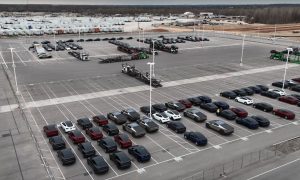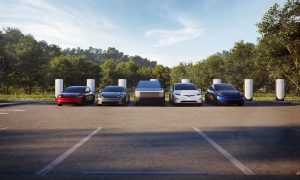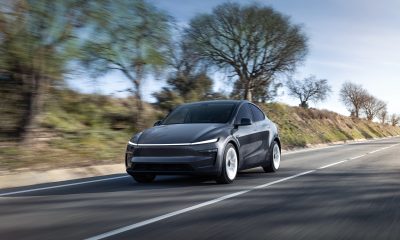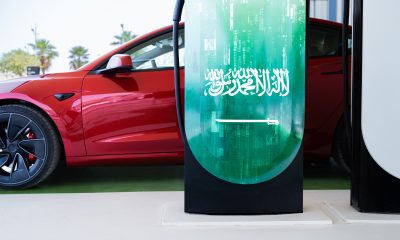Tesla’s global vehicle sales overtook those of one luxury automaker for the first time last year, despite the company also seeing its deliveries drop slightly from the prior year.
Volkswagen-owned luxury automaker Audi released its global sales this week, and for the first time ever, Tesla has outsold the German company on the global leaderboards, according to a report from Bloomberg. While Tesla announced that it sold 1.79 million vehicles for a drop of about 1.1 percent, Audi said it sold just 1.67 million vehicles across the world, marking a drop of 12 percent year over year.
The news marks the first time that Tesla has outsold the automaker throughout global markets, and it comes as German automakers have struggled with demand for their vehicles amidst a transition to electric models. Particularly, Audi’s sales saw drops in Germany, China and North America, while battery-electric deliveries dropped by about 8 percent to roughly 164,000 for Audi.
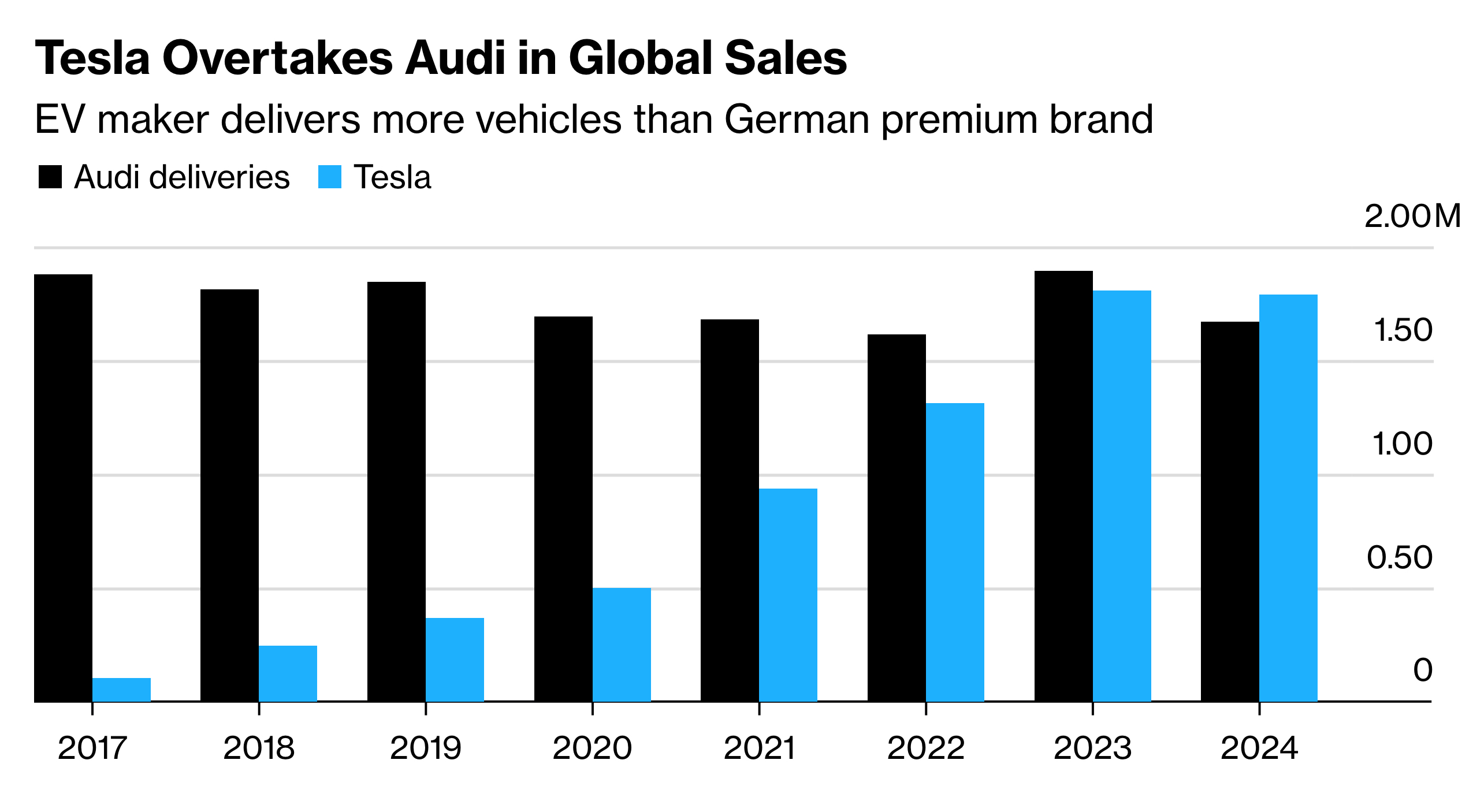
Credit: Bloomberg (data from company statements)
READ MORE ON VW-OWNED AUDI: Audi initiates recall for e-tron Quatro over brake failure issue
As can be seen in the graphic, 2024 is also the first year Audi hasn’t seen a sales increase in the last several years, with the company in 2023 selling about 1.9 million units.
In the U.S. alone, Audi sold 23,152 units, falling behind Tesla, the dominant market leader with 633,000 in the market, and a number of other automakers including General Motors (GM) (114,432), Ford (97,865), Hyundai (61,797), BMW (50,981), and a few others still. Audi did outsell its parent company Volkswagen in the U.S., with the fellow German automaker posting 18,183 deliveries in Tesla’s home market.
Audi has also announced plans to retire a factory in Brussels, Belgium, largely due to low demand for the company’s electric Q8 e-tron SUV, which the automaker currently builds there.
What are your thoughts? Let me know at zach@teslarati.com, find me on X at @zacharyvisconti, or send us tips at tips@teslarati.com.
Tesla vs. competition: How many BEVs did OEMs sell in the U.S. in 2024?
Need accessories for your Tesla? Check out the Teslarati Marketplace:
News
Underrated Tesla safety feature recognized by China Automotive Research Institute
Teslas are not just safe from electromagnetic radiation—they are among the safest vehicles in the market when it comes to radiation protection.

Electric vehicles like Tesla have become very common today, but this does not mean that they are immune to misinformation campaigns. One of these points of FUD (fear, uncertainty, and doubt) relates to EVs’ alleged electromagnetic radiation, which is supposedly a potential heath risk.
As per the China Automotive Research Institute, however, Teslas are not just safe from electromagnetic radiation—they are actually some of the safest vehicles in the market when it comes to radiation protection.
Tesla Model 3 and Model Y’s Results
As per Tesla China VP Grace Tao in a post on Weibo, the idea that electric vehicles expose occupants to electromagnetic radiation is a product of misinformation. As per the Tesla executive, the Model 3’s magnetic field strength near the driver and passenger’s head in the cabin only reaches 0.08-1.30μT, which is far lower than the magnetic field one would be exposed to if they use a conventional electric blanket.
“Taking Model 3 as an example, the magnetic field strength near the driver and passenger’s head in the car is only 0.08-1.30μT. In most cases, the magnetic field strength of an electric blanket close to the body is about 10-50μT, which is tens or even hundreds of times the strength inside a Tesla car, so car owners can rest assured,” Tao wrote in her post.
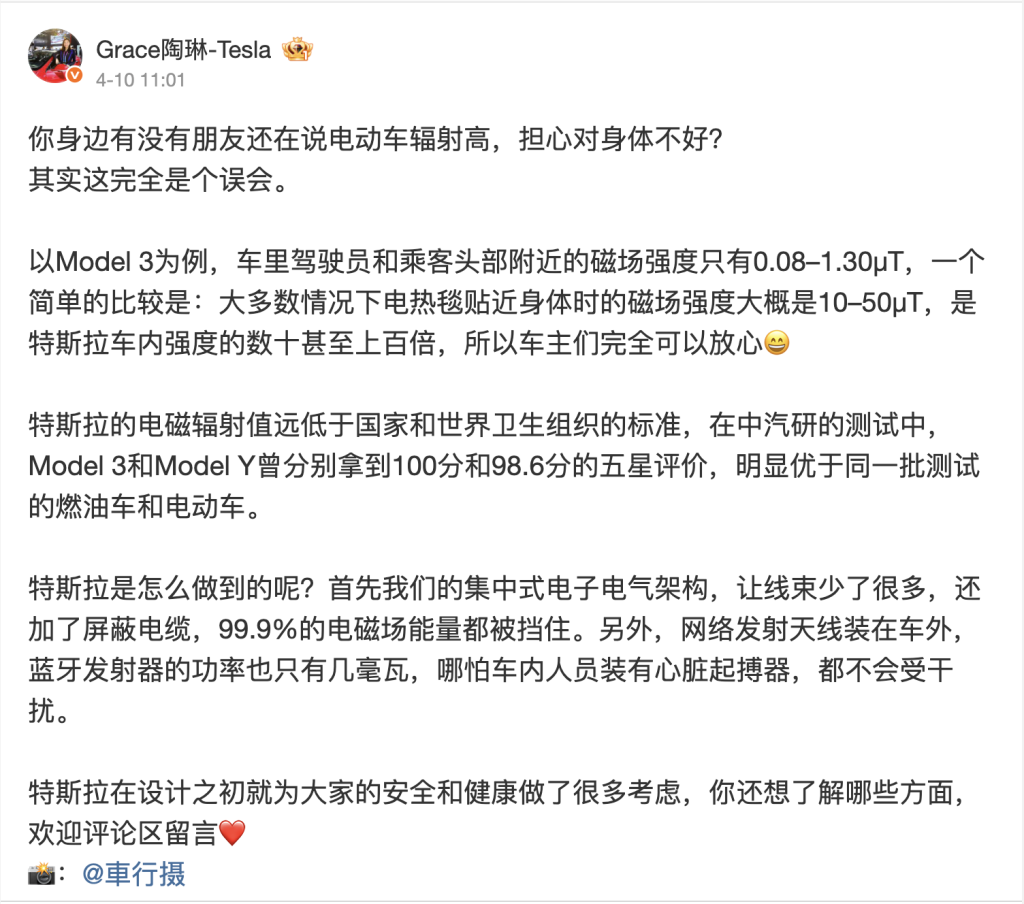
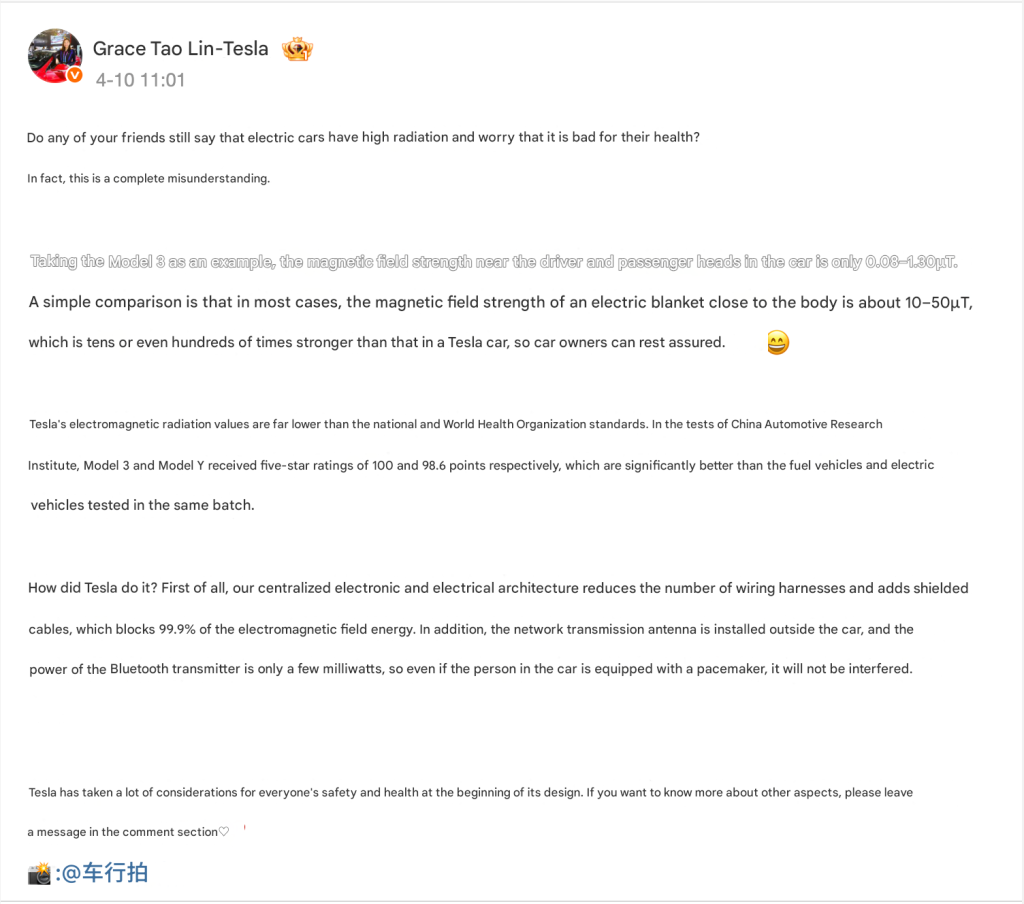
Beyond Standards
The Tesla VP added that the electromagnetic radiation values of Tesla’s vehicles are far lower than national and World Health Organization standards. During tests from the China Automotive Research Institute, the Model 3 and Model Y received five-star ratings of 100 and 98.6 points, which were notably better than combustion-powered cars and other electric vehicles that were tested in the same batch.
Tao explained how Tesla was able to achieve these scores below:
“How did Tesla do it? First of all, our centralized electronic and electrical architecture reduces the number of wiring harnesses a lot, and shielded cables are added, blocking 99.9% of the electromagnetic field energy. In addition, the network transmission antenna is installed outside the car, and the power of the Bluetooth transmitter is only a few milliwatts, so even if the people in the car are equipped with pacemakers, they will not be interfered with,” the Tesla VP wrote.
News
Starlink debuts in Somalia, continuing global expansion
Starlink lands in Somalia after lengthy talks with the gov’t. Local officials expect it to shake up costly, spotty service in rural areas.

Starlink-somalia-expansion-worldwide
Starlink launched in Somalia with government approval, expanding its global reach despite some Elon Musk backlash.
Over the weekend, Elon Musk announced that SpaceX’s Starlink internet service went live in Somalia after a Somalian government official confirmed the company secured an operating license. The rollout marks a milestone for internet access in a nation hungry for better service.
According to Reuters, Mustafa Yasiin, Somalia’s director of communication in the telecommunications ministry, detailed the two-and-a-half-year negotiation process with SpaceX for Starlink connectivity.
“We have been in talks with this company (Starlink) for a period of two and half years. We gave them the license today,” Yasiin said in a video on SONNA’s Facebook page. We hope Starlink will increase the quality of the existing internet in Somalia and will make the internet service reach more remote areas.”
Somalia’s internet landscape is often plagued by spotty coverage and high costs. As such, the country stands to gain from Starlink’s low-latency, high-speed offering. The satellite constellation targets remote regions that traditional providers usually skip. Yasiin’s optimism reflects Somalia’s push to bridge its digital divide, where only a fraction of the population enjoys reliable connectivity.
SpaceX’s entry follows a pattern of global expansion, with recent licenses in Brazil and elsewhere unlocking new markets. Somalia’s approval aligns with its telecom reforms, which aim to lure foreign players while boosting competition. Local providers like Hormuud Telecom may feel pressure as Starlink delivers services that ground infrastructure lag behind.
The license news underscores Musk’s knack for tapping underserved regions. However, challenges with Starlink, like affordability and local logistics, remain. Starlink’s Somalia debut could reshape how rural communities access education, commerce, and communication, mirroring its impact in other frontier markets. As SpaceX scales its constellation, the Somalia launch signals a broader ambition to blanket the globe, even as rivals like Amazon’s Kuiper eye similar orbits.
News
Tesla’s vehicles led U.S. EV sales again last quarter: report
Tesla, Ford, and Chevrolet’s models led the pack in Q1, while more new EVs hit the road than ever.
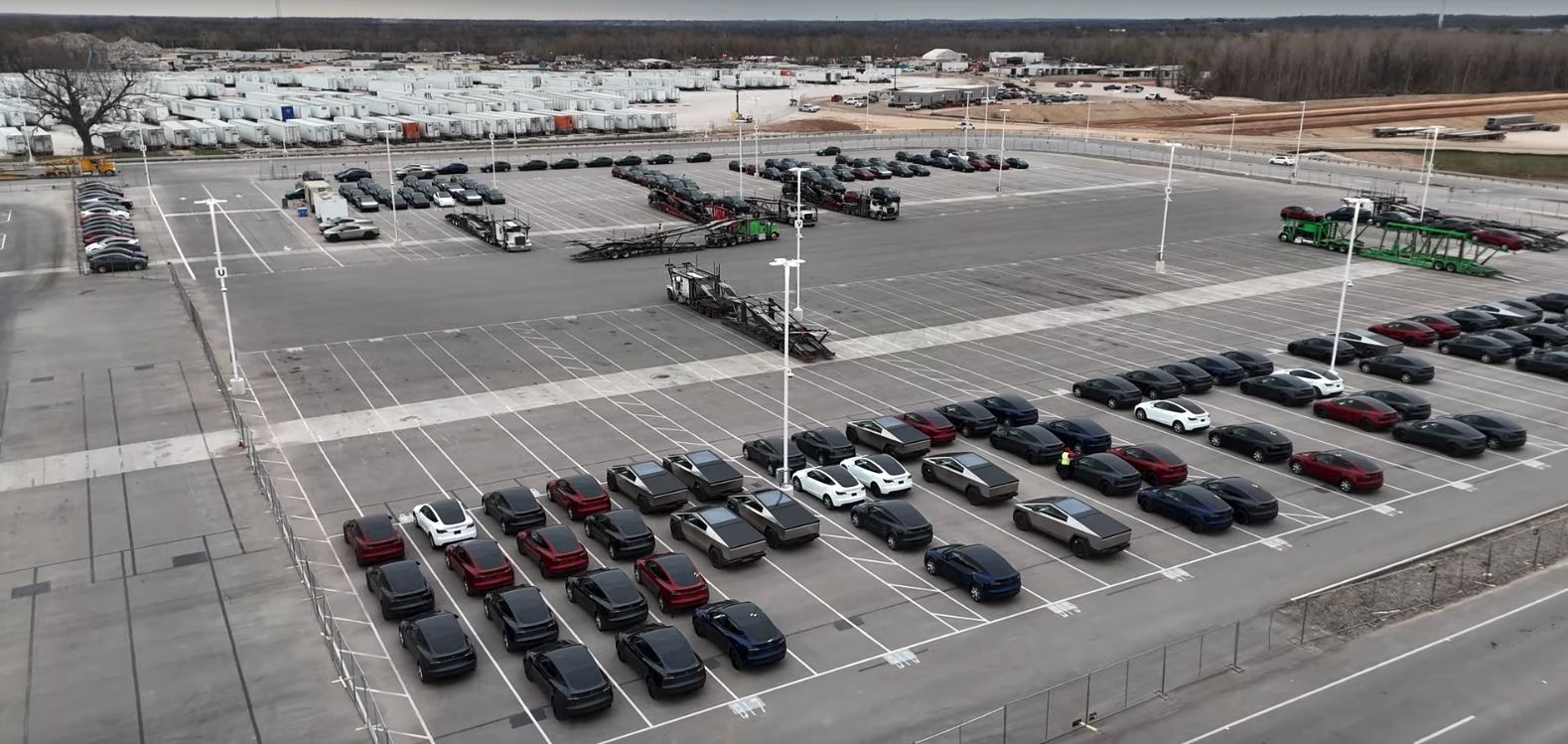
Recent data has shown that Tesla’s Model Y and Model 3 remained the top-selling electric vehicle (EV) models in the U.S. in the first quarter, despite a decline in overall sales in the market.
As detailed in the latest Kelley Blue Book EV sales report, shared by Cox Automotive on Thursday, Tesla’s Model Y and Model 3 outsold the next several models combined during the first quarter, while the Cybertruck was the tenth best-selling EV overall.
Tesla sold 64,051 Model Y units, representing a 33.8 percent drop year over year, along with selling 52,520 Model 3 units, marking a 70.3 percent increase year over year, to outpace the next several models combined. The Tesla Cybertruck sold 6,406 units, while the Model S and X sold 1,280 and 3,843 units, respectively.
Tesla also launched a new version of the Model Y in the first quarter, likely explaining at least a part of the decline, though the brand also faces continued pressure from the public, as many have targeted stores and vehicles in protesting Elon Musk and the Trump administration.
Meanwhile, the Ford Mustang Mach-E, the Chevy Equinox EV, and the Honda Prologue followed and made up the rest of the top five, with 11,607, 10,329, and 9,561 units sold, respectively. A number of models were also introduced to the market last year, such as the Porsche Macan, the VW ID.Buzz, and Volvo’s EX30 and EX90 models. Honda and Acura also added over 14,000 EVs to U.S. roads, marking an increase from having no products in Q1 2024.
Additionally, many models such as the Chevy Equinox EV, the Honda Prologue, and the VW ID.4 all climbed in the rankings from the full-year 2024 EV sales list, and it will be interesting to see how these and other emerging models hold as the year rolls on.
Cox also points out that Tesla’s overall sales were down 8.6 percent from last year’s first quarter, while General Motors (GM) sold over 30,000 EVs across its brands to lead the sector in sales growth.
See the full list of BEVs sold below, as ranked by volume. You can also check out the full Q1 EV sales data from Cox Automotive here, or read the firm’s press release on the report here.
READ MORE ON U.S. EV SALES: Tesla average transaction prices (ATP) rise in March 2025: Cox Automotive
EV models sold in the U.S. in Q1 2025, ranked by volume
- Tesla Model Y: 64,051
- Tesla Model 3: 52,520
- Ford Mustang Mach-E: 11,607
- Chevrolet Equinox EV: 10,329
- Honda Prologue: 9,561
- Hyundai Ioniq 5: 8,611
- VW ID.4: 7,663
- Ford F-150 Lightning: 7,187
- BMW i4: 7,125
- Tesla Cybertruck: 6,406
- Chevrolet Blazer EV: 6,187
- Toyota BZ4X: 5,610
- Rivian R1S: 5,357
- Cadillac Lyriq: 4,300
- Acura ZDX: 4,813
- Nissan Ariya: 4,148
- Tesla Model X: 3,843
- Ford E-Transit and Kia EV9 (tied): 3,756
- Kia EV6: 3,738
- BMW iX: 3,626
- GMC Hummer Truck/SUV: 3,479
- Porsche Macan: 3,339
- Hyundai Ioniq 6: 3,318
- Audi Q6 e-tron: 3,246
- Subaru Solterra: 3,131
- Chevrolet Silverado: 2,383
- Jeep Wagoneer EV: 2,595
- Nissan Leaf: 2,323
- Dodge Charger EV: 1,947
- Rivian R1T: 1,727
- Cadillac Escalade EV: 1,956
- VW ID.Buzz: 1,901
- BMW i5: 1,899
- Audi Q4 e-tron: 1,874
- Mercedes EQB: 1,622
- Cadillac Optiq: 1,716
- Rivian EDV500/700: 1,469
- Lexus RZ: 1,453
- Tesla Model S: 1,280
- GMC Sierra EV: 1,249
- Volvo EX30: 1,185
- Kia Niro: 1,162
- Porsche Taycan: 1,019
- Volvo EX90: 1,000
- Hyundai Kona EV: 914
- BMW i7: 888
- Mercedes EQE: 742
- Genesis GV60: 733
- Genesis GV70: 712
- Mini Countryman: 693
- Mercedes EQE: 742
- Audi Q8 e-tron: 535
- Mercedes G-Class and EQS (tied): 509
- Jaguar I-Pace: 381
- Volvo C40: 315
- Chevrolet Brightdrop 400/600: 274
- Audi e-tron: 250
- Volvo XC40: 218
- Mercedes E-Sprinter: 90
- Genesis G80: 51
- Chevrolet Bolt: 13
- Mini Cooper: 3
*Additional EV Models: 5,930
*The additional EV models category is likely made up of low-volume, luxury, and niche EV makers, such as those from Lucid and Polestar. However, at the time of writing, Cox Automotive has not yet responded to Teslarati’s request for comment on which vehicles were excluded.
Top 10 EV sellers by brand in the U.S. in Q1 2025
- Tesla: 128,100
- Ford: 22,500
- Chevrolet: 19,186
- BMW:13,538
- Hyundai: 12,843
- VW: 9,564
- Honda: 9,561
- Kia: 8,656
- Rivian: 8,553
- Cadillac: 7,972
-
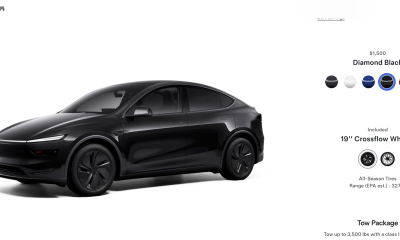
 News1 week ago
News1 week agoTesla rolls out new, more affordable trim of the Model Y Juniper in U.S.
-

 News2 weeks ago
News2 weeks agoTesla shares Optimus’ improved walk in new update video
-

 Elon Musk2 weeks ago
Elon Musk2 weeks agoTesla Germany reports 4,935 units sold in Q1 2025
-
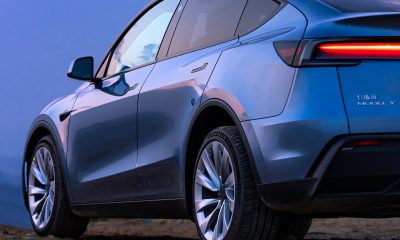
 Investor's Corner2 weeks ago
Investor's Corner2 weeks agoTesla (TSLA) shares company-compiled Q1 2025 delivery consensus
-
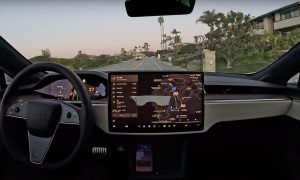
 News1 week ago
News1 week agoTesla expands Early Access Program (EAP) for early Full Self-Driving testing
-

 Elon Musk2 weeks ago
Elon Musk2 weeks agoNYC Comptroller moves to sue Tesla for securities violations
-

 News1 week ago
News1 week agoTesla celebrates key milestone for 4680 battery cell production cost
-

 News2 weeks ago
News2 weeks agoTesla’s Elon Musk reiterates ambitious Cybertruck water update




